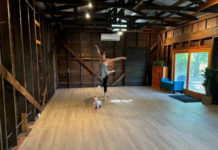Shonnie Brown
Lou’s house across from Riverview on South Fitch Mountain Road
is a trip in itself. We look at an 1876 photo of Healdsburg showing
where we now stand—at “the end of the road” before it turned to
gravel at the river’s bend. He then directs me to an 1879 telephone
which was given to him for payment on a bar tab.
“You crank it up till you hear three bells and then everyone on
the line listens in,” he jokes.
Lou then turns to the 1915 Edison Victrola. “It’s the same age
as me,” he notes, as he winds it up and crackly strains of Enrico
Caruso emerge from an ancient cylinder record.
In the trophy room/office, Lou now shows me his original desk
from Asti’s old Washington School. “I bought this desk when they
closed the old schoolhouse. I recall Mrs. Skagen gave me a whippin’
or two,” he laughs. “Today she’d be in jail.”
Lou likes 1915 collectibles. His favorite by far is his 1915
Ford Model T which won this year’s “Best of Show” and “Best of
Antiques” at the Geyserville Fall Colors Festival.
The trophy room is filled with blue ribbons for the car and for
heaven knows what else.
Ever the prankster, Lou now picks up a 1920 candlestick
telephone and dials it at random. He hands me the receiver, and
when I hear, “Hello?”, we both get nervous and I hang up,
suggesting we begin the interview.
Lou’s father, Eligio Colombano, came from Piedmonte, Italy. He
arrived first in June 1906 and spent a winter working in
Connecticut with his brother, Camilo. Then the two of them came out
to San Francisco right after the big earthquake. Eligio worked for
Stauffer Chemical Company while Camilo started a pre-Prohibition
wine and brandy delivery service. The wine was brought down from
Sonoma County, picked up and Camilo delivered it by horse and cart.
In 1913 Eligio returned to Italy to marry and bring back his bride,
Angela. Upon their return to San Francisco, Eligio began working
for a marble company, rebuilding the San Francisco City Hall which
had been thoroughly demolished by the 1906 quake.
In 1918, when Lou was a three year-old, the family moved to Asti
in Sonoma County. And Prohibition, beginning in 1920, put Camilo
out of work. The two brothers put their heads together and decided
to make their own wine and “Grappa” (wine brandy). Eligio, a farmer
back in Italy, grew vines, crushed grapes and made wine which
Camilo sold as a bootlegger. Camilo removed the seats from an old
Chandler automobile, installed copper tanks that were upholstered
over, and made his deliveries at night, thus keeping his customers
in the city. The wine came out a drain right into the jugs which
the customers provided. They produced a Claret — a blend of
different grapes. And Camilo’s North Beach customers were happy to
get anything.
At age five Lou started first grade at the old Washington School
in Asti in order to get a head start at learning English. There was
one teacher for all eight grades and Lou remained in the first
grade for two years. His dad then bought a ranch in Geyserville and
Uncle Camilo moved to Morgan Hill. Lou attended another year of
first grade at Geyserville Elementary and remained in Geyserville
schools until he was 16.
Like so many Italian ranchers of that era, the Colombanos were
mostly self-sufficient as they struggled through the Great
Depression years while living on the farm in Geyserville.
“I don’t think we would have survived if it weren’t for
bootlegging,” Lou tells me. “We had grapes and prunes, cows,
horses, chickens, rabbits, ducks and turkeys. We had plenty of milk
and made butter which I sold in town. Mom made cheese and baked
sourdough bread in an outdoor oven for 26 years. We grew
vegetables, canned food and butchered an occasional pig. We had
everything we needed except for flour and salt. Mom made our tee
shirts from flour sacks. When I was at school I tried my hardest to
hide the ‘Sperry flour’ label.
“There were five of us kids and I was the oldest. Then Dolly,
Vincent, Fred and Rita. We lived near the Russian River and when
the river flooded and we couldn’t go to school, we worked 24 hours
per day. At least the Prohibition officers couldn’t reach us when
it flooded! I ran the still during the day and Dad ran it at night
during the Prohibition years. I stayed on the farm until age 25
when my brother was old enough to take over.”
Lou shows me a well known photo of Catelli’s Restaurant from
August 14, 1937 in which he is tending bar in the company of local
ranchers and cowboys. He worked there at age 21 for $50 per month
plus room and board. He then worked at Italian Swiss Colony for 25¢
per hour doing pruning and digging ditches. When he began driving
the tractor, he earned an additional 10¢ per hour.
In 1940 Lou married Egle “Lee” Bacco, whose Italian immigrant
parents hailed from San Francisco’s North Beach. Lou and Lee bought
a house at Digger’s Bend on Bailhache Avenue from Mrs. Foppiano for
$1,200 while Lou was working for Basalt Rock Company. His work as
an operating engineer making asphalt used in local airstrips
fulfilled his service obligation during the war. Lou and Lee then
moved to and ran a prune orchard at what is now Riverview.
In 1946 the couple moved to San Francisco and started their bar
and restaurant, Rainbow Club, on Washington Street just a block
from the famous Transamerica Pyramid. They operated the restaurant
for the next 32 years.
“We’d start the day at 5:30 a.m. with the opening of the produce
markets,” Lou tells me. “Then the workers came from the poultry
houses and butcher shops. Then at 7:00 a.m. the white collar
workers from the immigration office began dribbling in. After that
we got the printing industry. They were all good eaters and
drinkers. Then the stockbrokers from Montgomery Street who enjoyed
liquid lunches at the end of an early day. I worked 12 to 14 hour
days and was looking for a pot of gold and never did find it!”
Lou and Lee had a son William and a daughter Louette. “We have
one grandson from William, named Marcus. We have two great
grandchildren, Maxmilliano Victorio Colombano and Vivienne
Colombano.”
Lou and Lee retired in Healdsburg when Lou was 62. In 1990 the
family had a huge 50th Anniversary party at the Villa. Lee passed
away in March 2004, but Lou’s life has remained full.
“I say that I went to school at the University of Geyserville,”
he laughs.
“All my old friends are gone but I continue to make new ones,”
he tells me, as he reaches into a cupboard and produces the very
last bottle of Eligio’s brandy.
Shonnie Brown is a Marriage and Family Therapist who is
interested in fostering connections between people and their
community. Shonnie also writes personal and family histories
through her business, Sonoma LifeStories. She can be reached by
e-mail at sh*****@so***.net
or on the web at www.sonomalifestories.com.
44
F
Healdsburg
January 12, 2025







